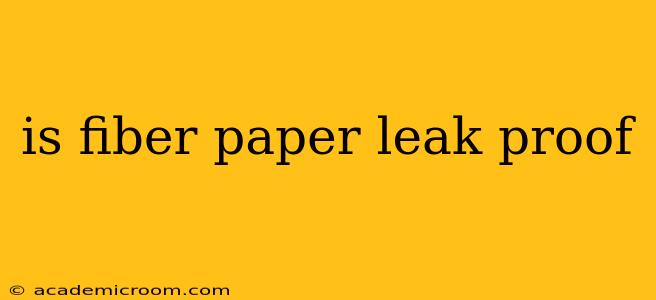Is Fiber Paper Leakproof? A Comprehensive Guide
Fiber paper, while incredibly versatile and useful in many applications, isn't inherently leakproof. The answer to whether your fiber paper is leakproof depends heavily on several factors. Let's delve into the details.
What is Fiber Paper?
Before we explore leakproofness, it's crucial to understand what fiber paper actually is. Fiber paper is a broad term encompassing various papers made from different plant fibers, often including recycled materials. The type of fiber, the paper's construction, its density, and any applied treatments all significantly impact its ability to resist liquids.
Factors Affecting Leakproofness
Several key factors determine whether a specific type of fiber paper will be leakproof:
-
Fiber Type and Density: Papers made from denser fibers, such as those found in high-quality cardstock or certain specialty papers, tend to be more resistant to liquid penetration than thinner, more porous papers. The tighter the fibers are interwoven, the less likely a liquid is to seep through.
-
Paper Treatment: Some fiber papers undergo treatments to enhance their water resistance. These treatments can include coatings, laminations, or special finishes that create a barrier against liquids. Untreated fiber paper, however, will generally absorb liquids.
-
Liquid Type: The type of liquid also matters. Water might seep through more easily than a thicker, more viscous liquid like oil. The liquid's temperature can also be a factor; hot liquids might be more likely to penetrate the paper.
-
Application and Pressure: The amount of pressure applied to the paper plays a role. A small amount of liquid might bead up on a dense paper surface, but applying significant pressure could force the liquid through.
H2: What Types of Fiber Paper Might Be Considered Leakproof (Relatively Speaking)?
While true leakproofness is rare for standard fiber paper, some types offer significantly better liquid resistance than others:
-
Laminated Fiber Paper: A layer of plastic or other waterproof material laminated to the fiber paper creates a significant barrier against leaks. This is commonly used in food packaging or for creating waterproof notepads.
-
Coated Fiber Paper: Coatings designed to resist water or oil can improve a fiber paper's leakproof properties. These papers are often used for packaging applications or in situations where minor liquid resistance is needed.
-
High-Density Fiberboard: This type of fiber paper is significantly denser and more resistant to liquids than standard paper. It's commonly used in applications where strength and moisture resistance are required.
H2: What Kinds of Fiber Paper are Definitely Not Leakproof?
Many everyday fiber papers are easily penetrated by liquids:
-
Standard Printing Paper: This is highly absorbent and will quickly become saturated with liquids.
-
Construction Paper: This paper is generally thin and porous and not suitable for containing liquids.
-
Tissue Paper: This paper is extremely porous and thin, rendering it completely unsuitable for any liquid containment.
H2: Can You Make Fiber Paper More Leakproof?
While you can't magically transform standard printing paper into a waterproof container, you can improve its resistance to liquids in some cases:
-
Applying a Coating: You can apply a layer of wax, sealant, or even a thin layer of paint to create a temporary barrier. The effectiveness will depend on the chosen material and the paper's porosity.
-
Using Multiple Layers: Layering multiple sheets of fiber paper together can increase its overall thickness and liquid resistance. However, this is not a reliable solution for containing significant volumes of liquid.
Conclusion:
The answer to "Is fiber paper leakproof?" is a resounding "It depends." While some treated or specially constructed fiber papers offer decent liquid resistance, many types of fiber paper are highly absorbent and unsuitable for containing liquids. Always consider the type of fiber paper, its treatment, and the intended application before assuming any level of leakproofness.
